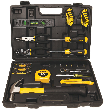Replacing a Three-Way Switch
Written by Lee Wyatt (last updated July 20, 2020)
Have you ever noticed how with some light switches it doesn't really matter which way is ON or OFF? That is because these types of switches work in pairs to help control a light source from separate locations. Whether a particular switch turns the light on or off is totally dependant upon where the position of the switch is located. Frankly, replacing a three-way switch is an easy task as long as you take proper care, and follow these instructions.
Materials needed:
- Three-way switch.
- Electricians tape
- Masking tape
- Tester
- Screwdriver
- Combination stripper
- Lineman's pliers
- Long-nosed pliers
Procedure:
- Shut off the power. Whenever you work with electricity you should always turn off the power to that area. This will help reduce the chance of any electrocution or harm. Shut the power off at the breaker box, and make sure that you leave a note saying not to turn it on until you do it yourself.
- Identify and tag the common wire. Using a screwdriver remove the cover plate to the switch. Test to make sure that the power is turned off by flipping the light switch a couple of times. If the light doesn't come on, then there is no power. Identify the common wire (which is usually attached to a terminal that is a different color than the rest). Double check to make sure that you have the correct wire by following it back to the terminal and seeing if the terminal is marked common. Place a little bit of masking tape on to this wire, and write a "C" on it for future reference.
- Wiring one cable. Many three-way switches only have one cable that comes into the box, identified by having three wires plus a ground. Use a voltage detector to test and see which wire is the "hot" wire. Attach that hot wire to the common terminal, and then attach the other two wires to the traveler terminals. Connect the grounds, and test your work.
- Wiring two cables. Sometimes a three-way switch will have two cables entering the box. This situation is identified by having three wires plus a ground coming in, as well as having another cable which provides two wires plus a ground. While it looks confusing, you will still only find three wire ends to work with. Once you have identified these wire ends, proceed just as if you had only one cable coming into the box.
Author Bio
Lee Wyatt
Contributor of numerous Tips.Net articles, Lee Wyatt is quickly becoming a regular "Jack of all trades." He is currently an independent contractor specializing in writing and editing. Contact him today for all of your writing and editing needs! Click here to contact. Learn more about Lee...
Designing Your Own Water Feature
If you are interested in installing a water feature into your landscape design, why not take the opportunity to design ...
Discover More
Baking Dish Conversions
Chances are pretty good that somewhere along the lines you have come across a recipe that says to use a baking dish that ...
Discover More
Homemade Air Freshener
Have you ever noticed just how expensive air fresheners are? Why spend all that money on something that you can make ...
Discover More
More Home Improvement Tips
Outdoor Lights
Outdoor lights are a necessity around the home for many different reasons. Some of these reasons include being able to ...
Discover More
Installing Cut-In Boxes
There will be times when you simply do not have enough electrical boxes in your home. When faced with such a situation, ...
Discover More
Installing Motion-Sensor Lights
Safety is always an important issue to homeowners, and there is almost always something that can be done to improve it ...
Discover More

Comments